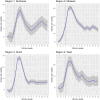School opening associated with lower test-adjusted COVID-19 case rates in children
- PMID: 40587416
- PMCID: PMC12208062
- DOI: 10.1093/ije/dyaf113
School opening associated with lower test-adjusted COVID-19 case rates in children
Abstract
Background: There is conflicting evidence from prior studies on the relationship between in-person schooling and transmission of SARS-CoV-2 among children. This may be due to multiple confounders in estimating this relationship, including the decision to close schools, community rates of infection, and rates of testing.
Methods: Regression-based observational study to estimate the relationship between school openings and COVID-19 case rates among children, while accounting for potential confounders including community case rates, mitigations in schools, and rates of testing among schoolchildren. The setting is US school districts in the Fall of 2021, from 3 weeks prior through 12 weeks after school opening, using restricted data obtained from the Centers for Disease Control and Prevention. Data were available for school districts in 2592 counties, containing 86% of the US population.
Results: School openings were associated with a brief rise in cases among children relative to adults, with a peak of 39.3 [37.7, 40.9] additional cases per 100 000 per week. However, children were tested at higher rates when schools were in session. After adjusting for testing rates, case rates among children were significantly lower after schools reopened by 4.7 cases per 100 000 compared with over summer break.
Conclusion: School reopening in the USA in the 2021-22 academic year was accompanied by an increase in SARS-CoV-2 testing in children and a brief rise in pediatric cases. When testing rates are accounted for, school reopening was associated with a decrease in COVID-19 cases among children relative to adults. A lower threshold for testing in the school setting may be an important confounder in studies of SARS-CoV-2 transmission.
Keywords: COVID-19; SARS-CoV-2 transmission; confounding; school openings; testing rates.
© The Author(s) 2025. Published by Oxford University Press on behalf of the International Epidemiological Association.
Conflict of interest statement
None declared.
Figures






Similar articles
-
Rapid, point-of-care antigen tests for diagnosis of SARS-CoV-2 infection.Cochrane Database Syst Rev. 2022 Jul 22;7(7):CD013705. doi: 10.1002/14651858.CD013705.pub3. Cochrane Database Syst Rev. 2022. PMID: 35866452 Free PMC article.
-
Measures implemented in the school setting to contain the COVID-19 pandemic.Cochrane Database Syst Rev. 2022 Jan 17;1(1):CD015029. doi: 10.1002/14651858.CD015029. Cochrane Database Syst Rev. 2022. Update in: Cochrane Database Syst Rev. 2024 May 2;5:CD015029. doi: 10.1002/14651858.CD015029.pub2. PMID: 35037252 Free PMC article. Updated.
-
COVID-19 Incidence and Age Eligibility for Elementary School.JAMA Netw Open. 2024 Nov 4;7(11):e2444836. doi: 10.1001/jamanetworkopen.2024.44836. JAMA Netw Open. 2024. PMID: 39541118 Free PMC article.
-
Signs and symptoms to determine if a patient presenting in primary care or hospital outpatient settings has COVID-19.Cochrane Database Syst Rev. 2022 May 20;5(5):CD013665. doi: 10.1002/14651858.CD013665.pub3. Cochrane Database Syst Rev. 2022. PMID: 35593186 Free PMC article.
-
Antibody tests for identification of current and past infection with SARS-CoV-2.Cochrane Database Syst Rev. 2022 Nov 17;11(11):CD013652. doi: 10.1002/14651858.CD013652.pub2. Cochrane Database Syst Rev. 2022. PMID: 36394900 Free PMC article.
References
-
- Centers for Disease Control. Operational Strategy for K-12 Schools Through Phased Prevention. National Center for Immunization and Respiratory Diseases (U.S.). Division of Viral Diseases. February 12, 2021. https://www.documentcloud.org/documents/20478594-cdc-k-12-operational-st... (10 June 2025, date last accessed).
-
- Bravata D et al. Back to school: the effect of school visits during COVID-19 on COVID-19 transmission. Working Paper 28645. National Bureau of Economic Research, 2021.
-
- Courtemanche CJ et al. School reopenings, mobility, and COVID-19 spread: evidence from Texas. WP 28753. National Bureau of Economic Research, 2021.
-
- Goldhaber D, Imberman SA, Strunk KO et al. To what extent does in‐person schooling contribute to the spread of Covid‐19? Evidence from Michigan and Washington. J Policy Anal Manage 2022;41:318–49.
Publication types
MeSH terms
LinkOut - more resources
Full Text Sources
Medical
Miscellaneous

